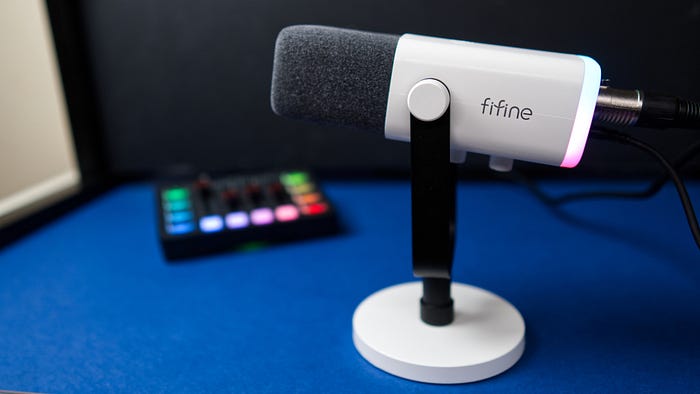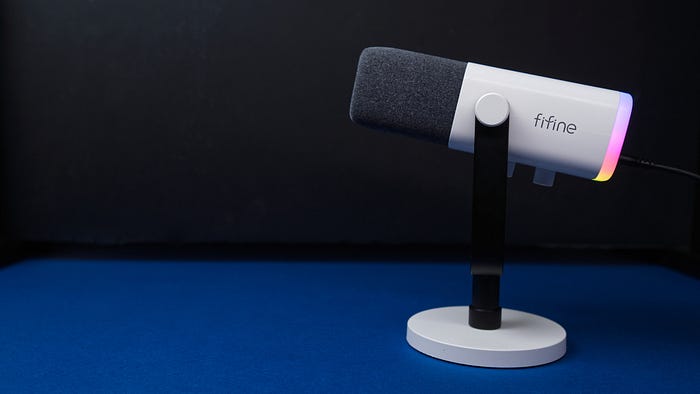Are you tired of sounding just like everyone else? Whether you’re crushing it in-game, streaming to your fans, or launching a podcast, your voice deserves to be heard the way it was meant to be, bold, clear, and professional.

Enter the Fifine AM8, a microphone that lets you choose between USB convenience and XLR power. I’ve been putting this hybrid mic to the test, from casual streaming to pro-level setups with a mixer.
Unboxing and first impressions
Right out of the box, the AM8 feels like a premium mic. Here we have the AM8 microphone itself, you also get a 6.5ft USB-C to USB cable and the base stand for the mic.

As with all other Fifine microphones the build quality is impressive, and as this microphone sits in the budget price range, makes this even better.
It’s sturdy, sleek, and comes in this clean white version that I’m using, that actually goes really well with my desk setup, though it’s also available in black and pink, giving you some colour choices to fit your setup.
On the top of the microphone, there is a removable foam cover aimed at reducing those plosive sounds. But if you prefer not to have this on, then you can always use it without it, but I just think the overall microphone looks better with it on and generally, the audio you’ll get with it on will only sound better.
On the front of the mic, there’s a touch sensitive button to control the RGB function, on and off by holding the button, and tapping the button will allow you to select between 8 static colours, 1 that alternates between the colours and 1 swirling multi-colour effect. There’s also the gain and headphone volume dials.
On the back, a tap to mute button, displaying green for live and red for muted. On the bottom of the microphone, slot for the XLR cable, one for the usb-c cable and a headphone jack to monitor your recordings in real time.
Dual Connectivity — USB & XLR
One of the standout features of the AM8 is that it’s a hybrid microphone, meaning you can use it in either USB mode or XLR mode. For gamers or streamers just starting out, the USB connection is perfect, it’s simple, plug-and-play, no need for any extra gear. But if you want to step up your audio game, the XLR option is where the magic happens.
Why choose an XLR mic? XLR microphones offer greater audio quality and flexibility. When paired with an audio interface or mixer like the Fifine SC3, you get more control over your sound, whether you’re adjusting EQ, compression, or just tweaking volume levels for different streams. We’ll get into that more when we run the tests.
[SECTION 3: SOUND TESTS & PERFORMANCE]
(Check out the video version of this article, to see the video test results)
The optimum recording range for this microphone is 2 to 6 inches and as this is a cardioid pattern microphone, you’re going to need to speak directly into the top of the microphone as it is going to reject sound coming from the other sides.
For the purpose of this review, I’ve been using the microphone as it comes out of the box, with it’s own base stand, which, depending on your own setup, will either be ideal or limiting. With the base stand off, you can mount this most boom arms which will give you better noise rejection leading to improved audio quality.
In USB mode, the AM8 delivers clear, full sound with minimal background noise.
It’s perfect for streamers, content creators, or anyone who just needs a reliable mic without the complexity of extra gear.
In XLR mode, I’m running the AM8 through the Fifine SC3 gaming audio mixer. This will give me greater control over the mic settings, allowing me to fine-tune my voice to get that rich, professional sound.
With the XLR connection, the sound quality steps up significantly. The audio is more dynamic, and if you’re doing podcasts, professional streams, or voiceovers, this level of customisation is key.
When you’re using this mic in USB mode, you’ve got access to the controls, mute, RGB and monitoring on the microphone itself but when in XLR mode, you haven’t got access to any of that as the microphone requires that power provided by the USB connection, which isn’t present in the XLR mode, but for monitoring and adjustments, you’ll probably already be using a mixer. If you do also want access to the RGB lights in XLR mode, all you will need to do is connect a USB-C cable. In this setup, the audio will still primarily use the XLR output rather than the USB output.
Features and use cases
The versatility of being able to use this microphone with a USB or XLR cable depending on your preference and the evolution of your own creative journey.
Producing that excellent to price ratio audio quality, which is a common theme for all of the microphones I’ve tested from Fifine.
The RGB lighting, because, let’s be real, we all want our gear to look as good as it sounds, especially if you’re live on Twitch or YouTube.
But, I understand that while RGB lighting is a cool feature, but isn’t for everyone.
Who is this Mic for?
It’s perfect for gamers, streamers, podcasters, and content creators, who want a high-quality mic without breaking the bank. If you’re starting out, the USB mode is super convenient, it’s plug and play, you’ll be able to use it on computers, Macs and a Playstation 4/5.
But, if you’re more serious about your audio and you want to grow with your setup, the XLR option gives you room to improve your sound quality as you invest in more gear, like this mixer.
Conclusion
The Fifine AM8 is a fantastic choice for anyone looking for a versatile mic, particularly if you’re using a headset or a USB only microphone.
The dual USB and XLR functionality, sturdy design, RGB lighting, and great audio performance make this a solid all-around mic.
Whether you’re just starting your streaming journey or you’re ready to upgrade to an XLR setup, the AM8 has got you covered.